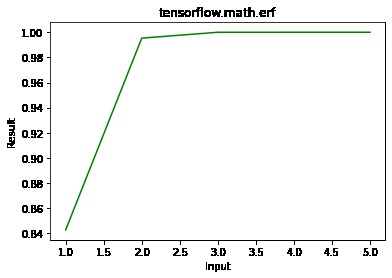TensorFlow是Google設計的開源Python庫,用於開發機器學習模型和深度學習神經網絡。
erf()用於計算元素明智的高斯誤差函數。
用法:tensorflow.math.erf( x, name)
參數:
- x:它是輸入張量。允許的dtypes是bfloat16,half,float32,float64。
- name(optional):它定義了操作的名稱。
返回值:它返回與x相同dtype的張量。
範例1:
Python3
# importing the library
import tensorflow as tf
# Initializing the input tensor
a = tf.constant([1, 2, 3, 4, 5], dtype = tf.float64)
# Printing the input tensor
print('Input:', a)
# Calculating Gauss error
res = tf.math.erf(x = a)
# Printing the result
print('Result:', res)輸出:
Input: tf.Tensor([1. 2. 3. 4. 5.], shape=(5, ), dtype=float64) Result: tf.Tensor([0.84270079 0.99532227 0.99997791 0.99999998 1. ], shape=(5, ), dtype=float64)
範例2:可視化
Python3
# importing the library
import tensorflow as tf
import matplotlib.pyplot as plt
# Initializing the input tensor
a = tf.constant([1, 2, 3, 4, 5], dtype = tf.float64)
# Calculating Gauss error
res = tf.math.erf(x = a)
# Plotting the graph
plt.plot(a, res, color ='green')
plt.title('tensorflow.math.erf')
plt.xlabel('Input')
plt.ylabel('Result')
plt.show()輸出:

相關用法
注:本文由純淨天空篩選整理自aman neekhara大神的英文原創作品 Python – tensorflow.math.erf()。非經特殊聲明,原始代碼版權歸原作者所有,本譯文未經允許或授權,請勿轉載或複製。
